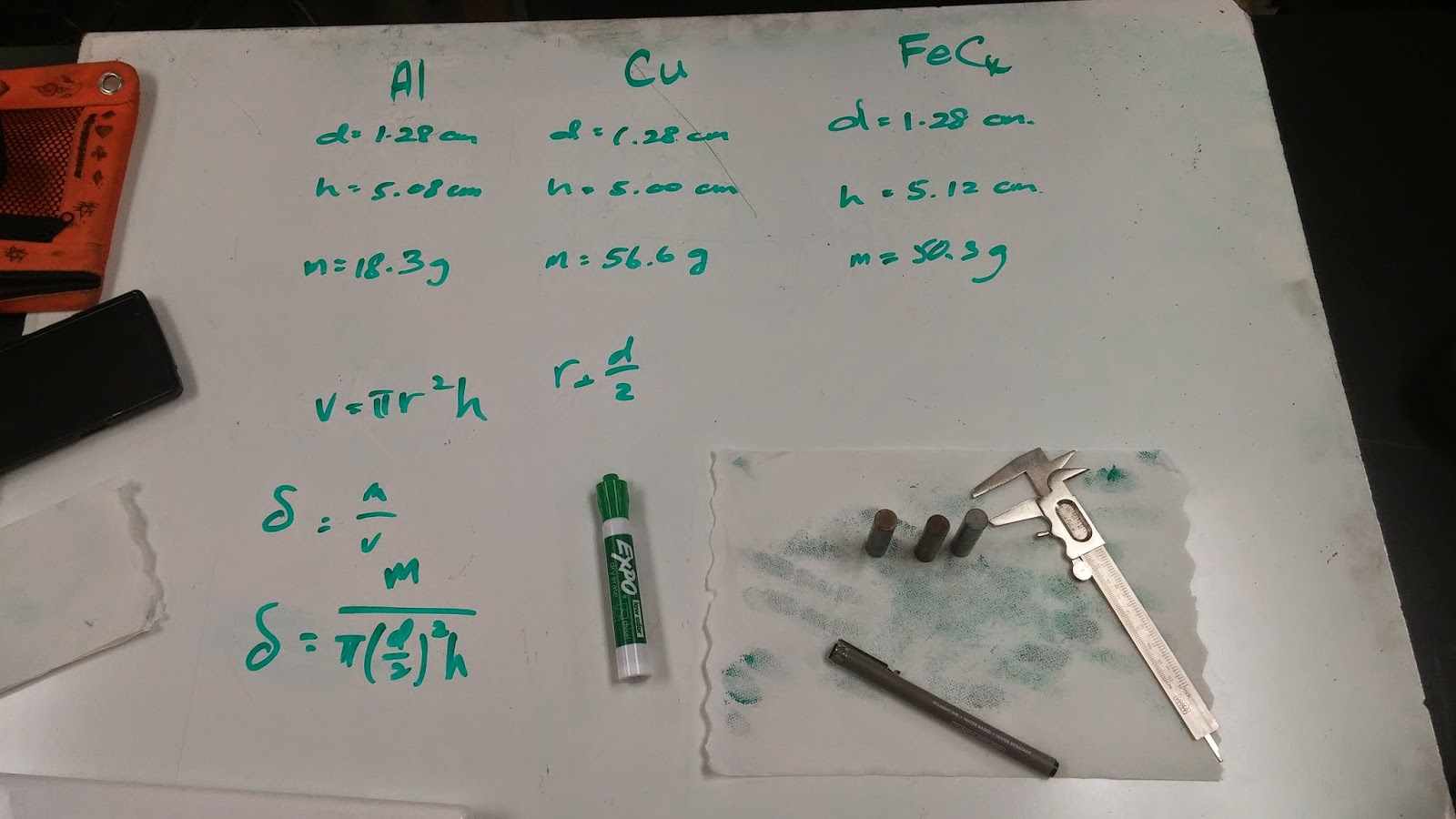The purpose of this lab was to make us understand that there is always uncertainty in every measurement even when using extremely accurate measurement tools. With this in mind, this lab is also designed to help us understand how to calculate this uncertainty into out measurements to be able to compensate for it.
First Procedure:
1. We were where given calipers to measure the seize of 3 different metallic cylinders. These were copper, aluminium, and steel.
2. These measurements were recorded
 |
| Steel left, Copper center, Aluminum right. Calipers are to the far right. Measurements were written here for easy viewing. |
4. To do partial integration, we basically make n number of equations and add them together, when n is the number of variables in an equation.
5. We then then treat each of these individually and take only the derivative of each. When doing this, we treat one as a variable and the rest as a constant.
6. Then when we had the final uncertainty, we plugged in out values to obtain the uncertainty in our measurements.
7. The values we got where the following:
First we measured the setups and found that setup 1 had the cable on the left being pulled at an angle north of west at 26 degrees with a force of 10.7N. The cable on the right was being pulled at 46 degrees north of east at 6.5N . We found that setup 2 was being pulled by a cable at 46 degrees north of west at 8N and another cable at 27degrees north of east with a force of 7N.
We used the recovered data and used it to try to identify the mass of the object in these two setups. Then we took a partial derivative of the mass function in order to find the uncertainty in our measurements of angles and force. Then we simply plugged in the values we had (in this case the work here is setup 2) and solved for our uncertainty in the mass.
8. The uncertainty for our densities where:
Aluminum was off by + or - 0.2390g/cm
Copper was off by + or - 0.24885g/cm
Steel was off by + or - 0.2372g/cm
Part 2:
For this part we used setup #1 and #2
 |
| Setup 1 |
 |
| Setup 2 |
First we measured the setups and found that setup 1 had the cable on the left being pulled at an angle north of west at 26 degrees with a force of 10.7N. The cable on the right was being pulled at 46 degrees north of east at 6.5N . We found that setup 2 was being pulled by a cable at 46 degrees north of west at 8N and another cable at 27degrees north of east with a force of 7N.
We used the recovered data and used it to try to identify the mass of the object in these two setups. Then we took a partial derivative of the mass function in order to find the uncertainty in our measurements of angles and force. Then we simply plugged in the values we had (in this case the work here is setup 2) and solved for our uncertainty in the mass.
In the case of set-up #2 the mass was .91kg+- .319kg
Summary:
In this lab we learned to calculate the uncertainty in measurements done in a lab. Part one allowed us to do this when we tried to calculate the mass of our three cylinders. The first step as we saw was to set up an equation for that which we plan to calculate and then take the partial derivative of it and plug in our measured values. We take this uncertainty and add it to our calculated value. Uncertainty value is calculated because we know there is error in our calculation, both of human and instrumental type. It is important to calculate this in to our value to have a broader understanding of what the actual value is, in this sense a range of values in which the real value is located. As we saw in the second part of the lab, the uncertainty might not seem much at first, but once we start working with heavier objects this uncertainty rises accounting for considerable large changes to our measurments.



No comments:
Post a Comment